For history buffs and culture enthusiasts, India is a treasure trove, brimming with architectural marvels, ancient pilgrimage sites, and remnants of empires long gone. This guide will unveil the best historical places to visit in India, taking you on a captivating journey through time. Get ready to be awestruck by the Taj Mahal’s ethereal beauty, delve into the intricate carvings of Ajanta and Ellora Caves, and stand in silent reverence at the Victoria Memorial. A journey through the “Top 10 historical places of India” unveils the rich tapestry of the nation’s past, from ancient empires to colonial legacies. So, pack your bags, unleash your inner explorer, and embark on an unforgettable adventure through India’s glorious past!
India is home to a wealth of historical treasures, each narrating stories of bygone eras, architectural brilliance, and cultural heritage. Here are some of the iconic historical places that you must explore:
1. Taj Mahal
An architectural masterpiece and enduring symbol of love, the Taj Mahal is one of the Seven Wonders of the World and is proudly located in Agra, India. The Taj Mahal, a magnificent example of Mughal architecture that blends Persian, Islamic, and Indian influences, was constructed in the 17th century by Mughal Emperor Shah Jahan in honor of his adored wife, Mumtaz Mahal. Depending on the time of day, this magnificent mausoleum, which is made of pure white Makrana marble, shimmers in various colors, pinkish at dawn, dazzling white in the afternoon, and golden under the moonlight. The main tomb, which is embellished with elaborate calligraphy, floral designs, and semi-precious stone inlays, is part of the Taj Mahal complex, which also includes a mosque, a guesthouse, a grand entrance gate, and lush Mughal gardens.
Four minarets, each slightly angled outward to prevent the main structure from collapsing in the event of an earthquake, encircle the tomb’s 73-meter-tall central dome. The actual graves of Mumtaz Mahal and Shah Jahan are located in a lower crypt, while the interiors include an elaborately decorated cenotaph. The Taj Mahal is one of the most well-known tourist destinations in the world, drawing millions of tourists annually as a UNESCO World Heritage Site. Conservation efforts continue to preserve its beauty despite obstacles like pollution and environmental threats. The Taj Mahal exemplifies timeless love, artistry, and India’s rich history, whether you view it up close or from the Yamuna River. It is an experience of a lifetime to visit this magnificent monument.
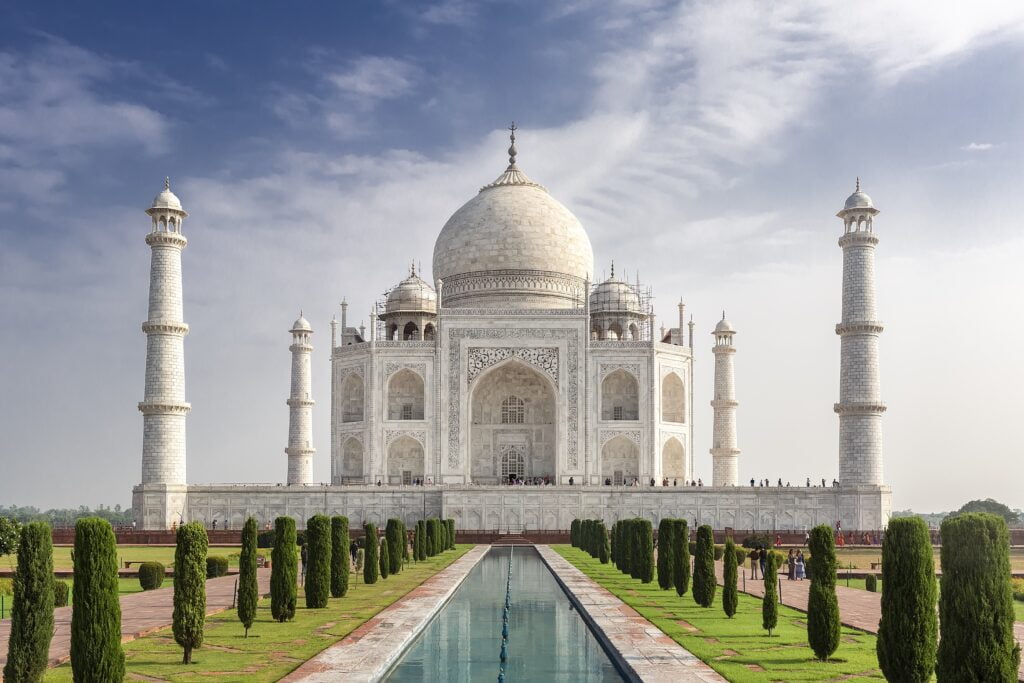
2. Qutub Minar
One of Delhi, India’s most recognizable historical landmarks is the Qutub Minar, which is a UNESCO World Heritage Site. With a height of 73 meters (240 feet), it is the world’s tallest brick minaret and a magnificent illustration of Indo-Islamic design. Qutb-ud-din Aibak, the founder of the Delhi Sultanate, constructed the minaret in 1193. Firoz Shah Tughlaq and Iltutmish later added to it. Constructed primarily from marble and red sandstone, artisans adorned the tower with Quranic verses, geometric patterns, and intricate calligraphy. Some historically significant buildings surround the Qutub Minar, such as the Iron Pillar of Delhi, an enigmatic 1,600-year-old column that has not rusted, and the Quwwat-ul-Islam Mosque, the first mosque constructed in India.
Balconies supported by elaborate brackets identify each of the minaret’s five separate stories. It exhibits remarkable architectural precision as it rises, tapering from a base diameter of 14.3 meters to a top diameter of 2.7 meters. Despite centuries of earthquake damage, it has undergone meticulous restoration and is still a well-known representation of India’s rich history. Explore the Qutub Complex, which also houses the Tomb of Iltutmish, Alai Darwaza, and Alauddin Khilji’s Madrasa. With its fascinating history and exquisite craftsmanship, the Qutub Minar never fails to enthrall visitors from all over the world and provide a window into India’s illustrious past. It is a must-see location for both history and architecture lovers due to its imposing presence against the Delhi skyline.
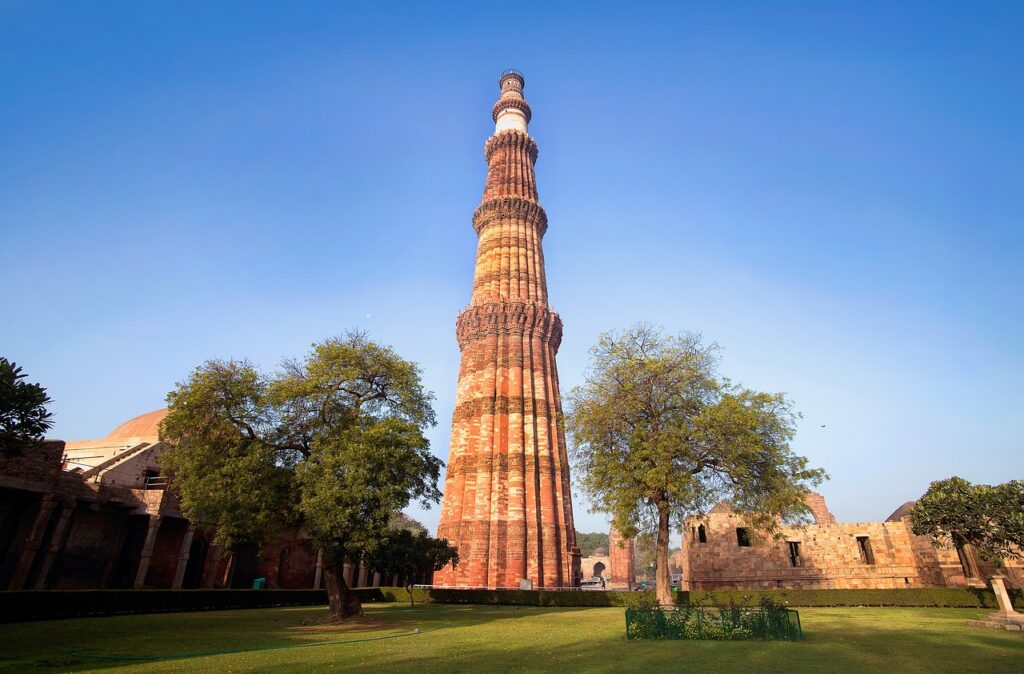
3.Ajanta and Ellora Caves
Artisans created the Ajanta and Ellora Caves, located in Maharashtra’s Aurangabad district, showcasing India’s rich religious and artistic heritage. Recognized as a UNESCO World Heritage Site, these caves showcase magnificent paintings, intricate sculptures, and remarkable architectural brilliance from antiquity. Ancient artisans carved the Ajanta Caves between the second and sixth centuries BCE, showcasing breathtaking Buddhist rock-cut architecture. They consist of 29 caves with captivating sculptures, murals, and frescoes that portray scenes from the Jataka stories, which tell of Lord Buddha’s past incarnations. Ancient Indian painters showcased their artistic brilliance through the intricate and profound cave paintings of Bodhisattva Padmapani and Vajrapani.
Artisans constructed the Ellora Caves, a blend of Buddhist, Jain, and Hindu temples, between the sixth and tenth centuries CE. This site, which has 34 caves, is a representation of both architectural mastery and religious harmony. Artisans carved the Kailasa Temple (Cave 16), Ellora’s most renowned structure, from a single rock, dedicating it to Lord Shiva as an engineering marvel. Ellora’s Hindu, Buddhist, and Jain influences embody India’s rich spiritual and cultural diversity. In addition to being historical landmarks, these caves serve as inspiration for historians and artists everywhere. Visiting Ajanta and Ellora offers a deep insight into India’s glorious past, making them must-visit destinations for travelers fascinated by history, spirituality, and ancient craftsmanship.
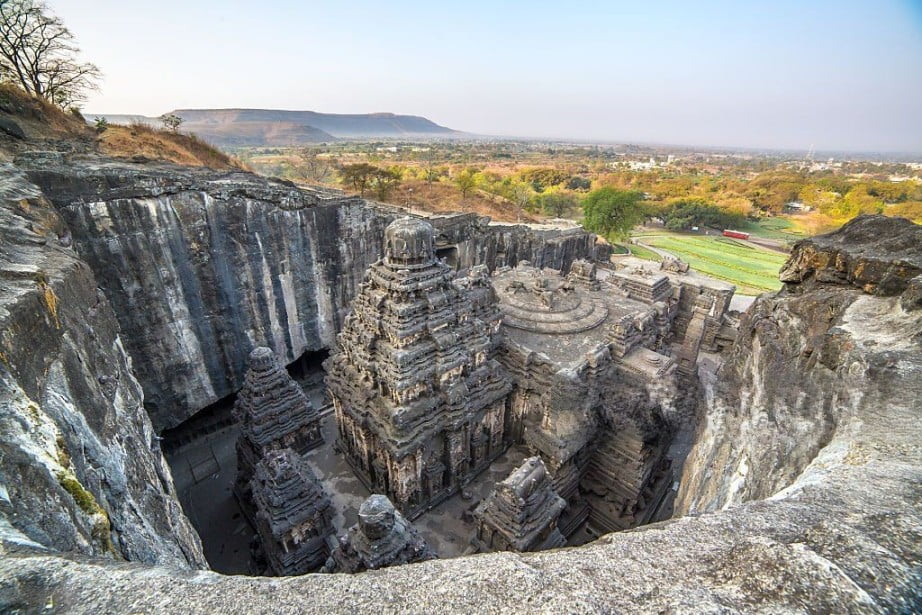
4. Fatehpur Sikri
One of the most amazing historical sites in India is Fatehpur Sikri, a magnificent city constructed by the Mughal Emperor Akbar in the late 16th century. This UNESCO World Heritage Site, an abandoned Mughal capital in Uttar Pradesh, is roughly 40 km from Agra and is renowned for its exquisite fusion of Islamic, Indian, and Persian architecture. Fatehpur Sikri, Akbar’s capital from 1571 to 1585, was mainly constructed of red sandstone before being abandoned because of a water shortage. The city was built in honor of Sheikh Salim Chishti, a Sufi saint whose blessings resulted in the birth of Prince Salim (Jahangir), Akbar’s son.
Fatehpur Sikri’s magnificent palaces, courtyards, mosques, and audience halls all showcase its magnificence. The Buland Darwaza, a 54-meter-tall gateway constructed to honor Akbar’s conquest of Gujarat, is one of its most recognizable buildings. An architectural masterpiece, this imposing entrance features elaborate carvings and Quranic inscriptions. While the Tomb of Sheikh Salim Chishti, which is still a popular pilgrimage site, is decorated with delicate marble lattice screens (jali work), the Jama Masjid, one of India’s largest mosques, radiates spiritual significance.
Other noteworthy sights include the Panch Mahal, a five-story palace intended to provide a refreshing haven in the summer, and the Diwan-i-Khas (Hall of Private Audience), which houses the unusual Lotus Throne. Akbar’s respect for diverse cultures is evident in the Jodha Bai Palace, which features Rajput and Mughal architectural styles. Fatehpur Sikri is a must-visit location for history buffs and tourists wishing to learn more about India’s illustrious past, even though it is now a ghost city.
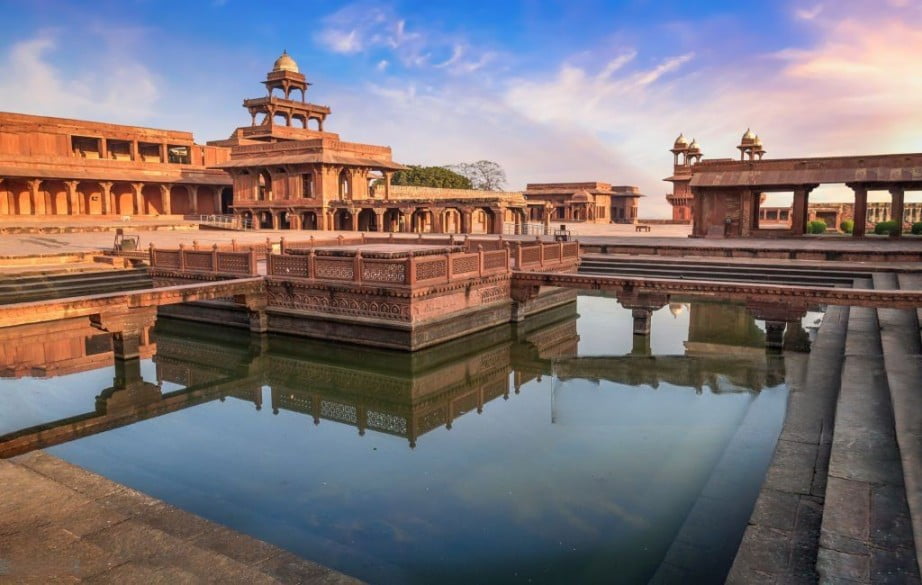
5. Gwalior Fort, Gwalior
One of the most impressive forts in India is Gwalior Fort, which is situated in Madhya Pradesh. It offers stunning views from its position atop a 300-foot hill. The Rajputs, Mughals, and Marathas all had an impact on the fort’s more than 1,000-year history. Constructed in the eighth century, it has seen many conflicts and governing changes. During the 15th century, Rajput ruler Man Singh Tomar was instrumental in its growth. The fort’s enormous sandstone walls, elaborate carvings, and imposing structures all demonstrate its architectural genius. Currently an archaeological museum, the Gujari Mahal was constructed for Queen Mrignayani. The Vishnu-focused Sas Bahu Temples feature beautiful craftsmanship and carvings. The Mughal influences on the fort are evident in Jahangir Mahal and Shah Jahan Mahal.
The Man Mandir Palace, with its underground chambers and blue-tiled façade, is a major attraction. The Gurdwara Data Bandi Chhod, dedicated to mentor Hargobind Sahib, the sixth Sikh mentor, is also located within the fort. Jain influence can be seen in the Tirthankaras depicted in the Jain sculptures carved into the rock face of the fort. Urwahi and Hathi Pol, the fort’s gates, are imposing and important historically. The fort is a must-see because of its advantageous location, stunning architecture, and historical significance. Because of its unbreakable defenses, it is referred to as the “Gibraltar of India.” It continues to be a representation of Gwalior’s rich history today, drawing tourists, historians, and photographers alike.
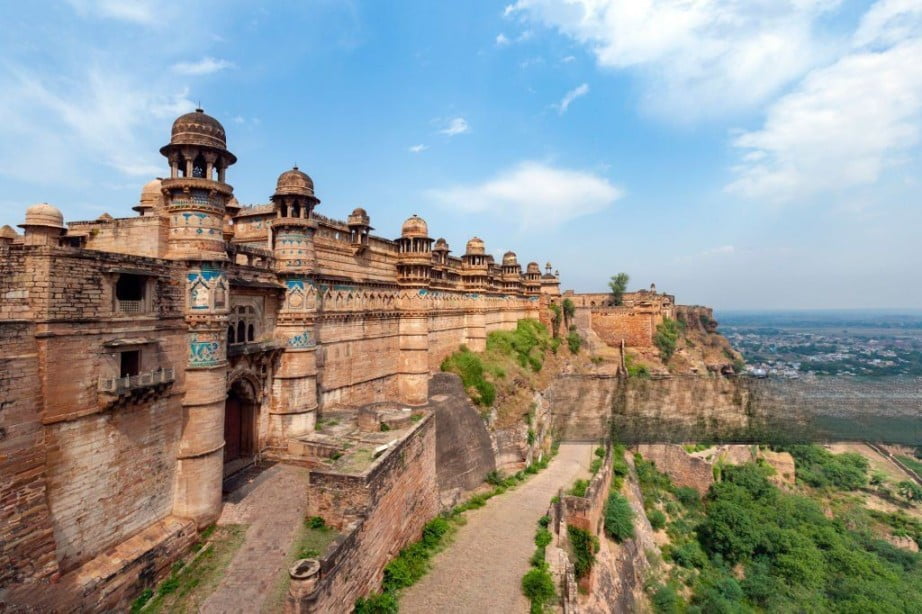
6. Hampi,Karnataka
A UNESCO World Heritage Site, Hampi, Karnataka, is a veritable gold mine of culture, history, and architecture. This magnificent city was constructed in the fourteenth century by the Vijayanagara Empire. It was a thriving capital and a center of religion, art, and trade. Its temples and ruins now draw tourists, historians, and lovers of architecture. The oldest and most important place of worship in Hampi is the Virupaksha Temple, which is devoted to Lord Shiva. The architectural splendor of the empire is on display at the Vittala Temple, which is well-known for its stone chariot and musical pillars. The elaborate carvings at the Hazara Rama Temple tell the story of the Ramayana. The Lotus Mahal was a royal retreat with a blend of Indo-Islamic architecture.
Once a thriving commercial hub, the Hampi Bazaar now provides a window into the city’s illustrious past. The royal elephants were kept in the Elephant Stables, which have a distinctive architectural design. The Queen’s Bath, an elaborate bathing complex, highlights the opulent lifestyle of the empire. Nestled amidst rocky terrain, the Achyutaraya Temple continues to be a unique destination. The Tungabhadra River, flowing alongside the ruins, enhances the site’s beauty. Visitors can explore historic pathways, sunrise vistas, and coracle rides. The best place to see sunrise and sunset is on Matanga Hill, which offers a panoramic view. Each stone in Hampi narrates a tale of majesty, devotion, and tenacity. Adventure, spirituality, and history are all combined for visitors to experience this ancient marvel.
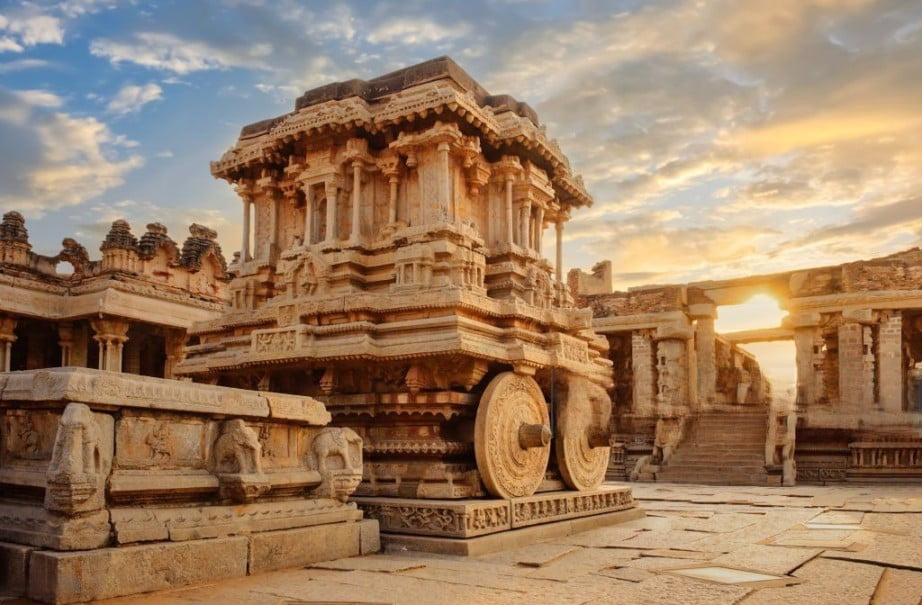
7. Victoria Memorial, Kolkata
The Victoria Memorial in Kolkata is a magnificent representation of Indian history and British colonial architecture. The renowned architect Sir William Emerson designed this magnificent monument. The 64-acre memorial gardens provide a calm and lovely setting. The elegance of the central dome, adorned with the Angel of Victory, mesmerizes visitors. The memorial has a large museum with rare manuscripts, paintings, and artifacts on display. British monarchs and Queen Victoria’s portraits are on display at the Royal Gallery. The later-added Calcutta Gallery features intricate exhibits that depict Kolkata’s colonial past. The library attracts scholars and researchers with its extensive collection of historical books. The statues and sculptures throughout the gardens portray important historical figures.
The enormous building, which blends British, Mughal, and Indo-Saracenic architectural styles, is a sight to behold. The elaborately carved marble hallways exhibit elegance and skill. Through engrossing imagery and narrative, the evening light and sound show tells the story of India’s colonial past. In addition to exploring the ornamental lakes surrounding the memorial, visitors can take leisurely walks and take in the lush surroundings. One of Kolkata’s main draws for tourists, art lovers, and history buffs is the Victoria Memorial.
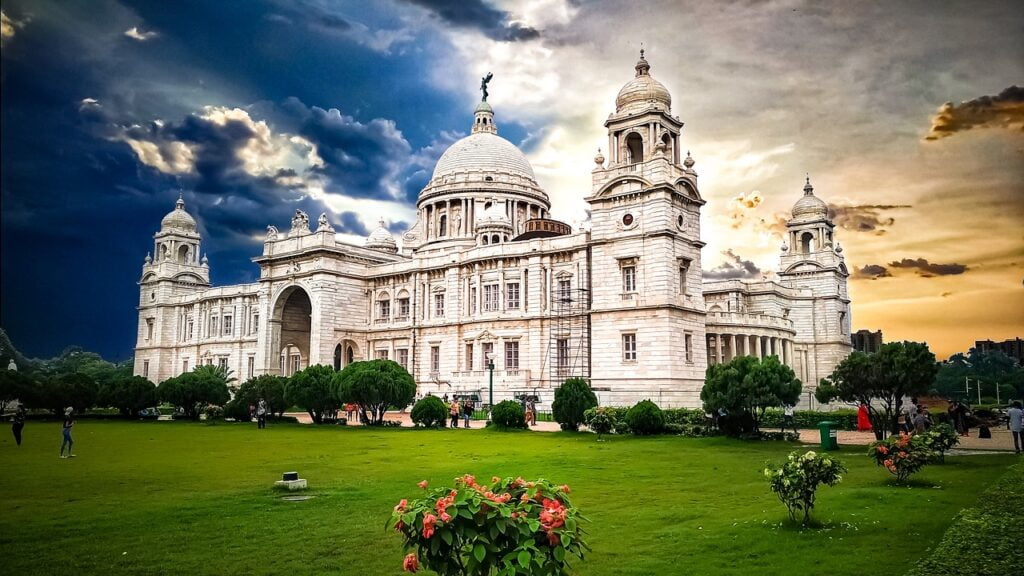
8. Sanchi Stupa
One of the oldest stone buildings in India, the Sanchi Stupa is a testament to both architectural genius and Buddhist heritage. In the third century BCE, Emperor Ashoka ordered the construction of this magnificent monument. The great stupa was expertly built by craftspeople, and its sturdy dome contained Buddha’s relics. Constructed from brick and sandstone, the enormous hemispherical building exudes peace and spiritual significance.
The four intricately carved gateways, known as Toranas, are sculptures that portray the life and teachings of the Buddha. Buddha’s miracles are depicted in the Western Torana, while Prince Siddhartha’s renunciation is shown in the Eastern Torana. The Northern gateway symbolizes divine blessings, while the Southern gateway depicts Ashoka’s conversion to Buddhism. Every sculpture narrates an intriguing tale from the history of Buddhism.
Following the meditative path, monks and devotees conduct ceremonial circumambulation around the stupa. The stupa’s surrounding railings maintain its sacred aura while adding to its grandeur. Inscriptions on stone pillars reveal influences from the Mauryan, Shunga, and Gupta periods. The Ashokan Pillar exhibits superb craftsmanship with its polished sandstone finish.
Visitors, historians, and spiritual seekers are all drawn to the site by its serene atmosphere. Because of its religious and cultural significance, UNESCO designated Sanchi Stupa as a World Heritage Site. While taking in the stunning surroundings, tourists explore the stupa’s architectural wonders. Coins, sculptures, and ancient relics from various dynasties can be found at the nearby museum. Sanchi Stupa’s mystical appeal is enhanced by the captivating sight of the sunrise over it.
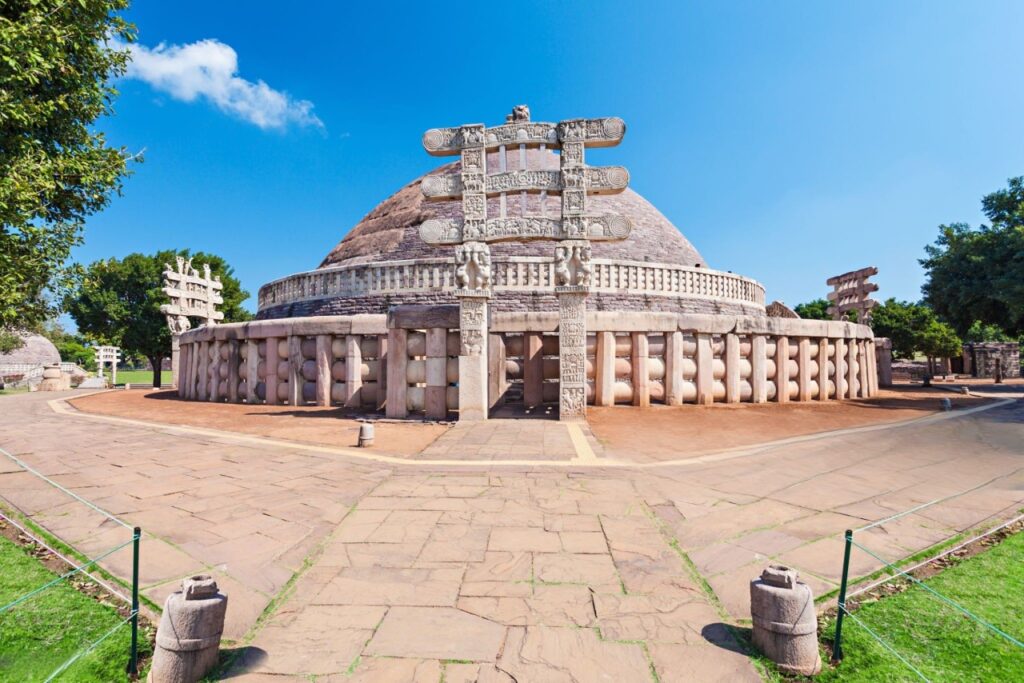
9. Amer Fort, Rajasthan
Amer Fort is a magnificent fortress in Jaipur, Rajasthan, with a rich history and exquisite Rajput architecture. UNESCO recognized Amer Fort as a World Heritage Site, preserving its architectural brilliance.Raja Man Singh I built this magnificent fort in 1592. Perched atop a hill, the enormous sandstone and marble building provides stunning views of Maota Lake. The expansive courtyards are accessible to visitors via the magnificent Suraj Pol (Sun Gate).
The Diwan-i-Aam, or Hall of Public Audience, has arched gateways and pillars with elaborate carvings. The elaborate ceiling and delicate floral designs of the Diwan-i-Khas (Hall of Private Audience) make an impression. The Sheesh Mahal, also known as the Mirror Palace, captivates tourists with its thousands of glittering mirrors that exquisitely reflect light. In these graceful halls, Rajput kings and queens delighted in their royal assemblies.
With a rich history and stunning Rajput architecture, Amer Fort is a magnificent fortress located in Jaipur, Rajasthan. Raja Man Singh I built this magnificent fort in 1592. Perched on a hill, the massive marble and sandstone structure provides breathtaking views of Maota Lake. Visitors can enter the vast courtyards through the magnificent Suraj Pol (Sun Gate).
The Hall of Public Audience, or Diwan-i-Aam, features ornately carved pillars and arched gateways. The Diwan-i-Khas (Hall of Private Audience) is striking due to its ornate ceiling and delicate floral designs. The Sheesh Mahal, also known as the Mirror Palace, mesmerizes tourists with its thousands of sparkling mirrors that reflect light beautifully. Rajput kings and queens enjoyed their royal assemblies in these elegant halls.
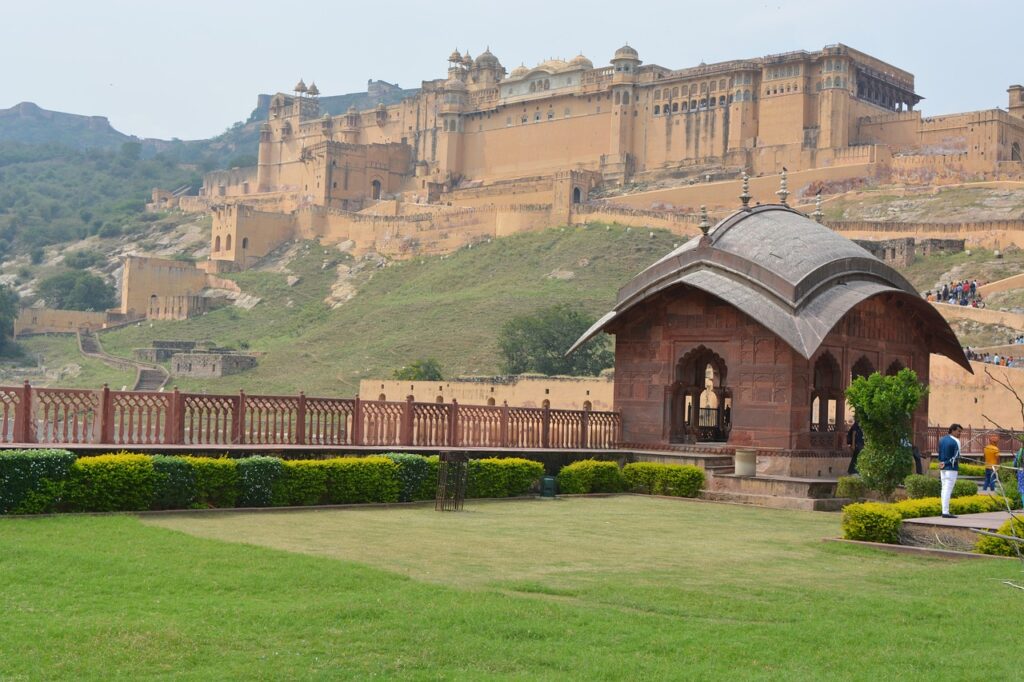
10. Khajuraho Temple, Madhya Pradesh
Khajuraho Temple, a UNESCO World Heritage Site, showcases India’s finest temple architecture. The Chandela dynasty built these magnificent temples between 950 and 1050 AD. Only 25 of the complex’s 85 temples are still standing. The temples feature scenes from everyday life, mythological tales, and elaborate carvings. The well-known Kandariya Mahadeva Temple, devoted to Lord Shiva, is part of the Western Group of Temples. This temple features beautiful sculptures and towering spires. Artisans intricately carved deities, apsaras, and other celestial beings at the Lakshmana Temple, dedicating it to Lord Vishnu. The Devi Jagdambi Temple houses a stunning idol of Goddess Parvati.
The Jain and Hindu temples in the Eastern and Southern Groups showcase artistic diversity. Artisans adorned the Parsvanath Temple, dedicated to Lord Mahavira, with intricate carvings of gods and natural themes. They crafted delicate, exquisite sculptures at the Duladeo Temple, devoted to Lord Shiva. With exquisite craftsmanship, Khajuraho’s sculptures honor human emotions, love, and devotion. The temples’ erotic carvings stand for spirituality, fertility, and life. The temples’ elevated platforms, elaborate pillars, and domed towers are all examples of Nagara-style architecture. Visitors examine the exquisite stone carvings, taking in their beauty and accuracy. The temples continue to be a popular destination for pilgrims and a representation of India’s rich past.
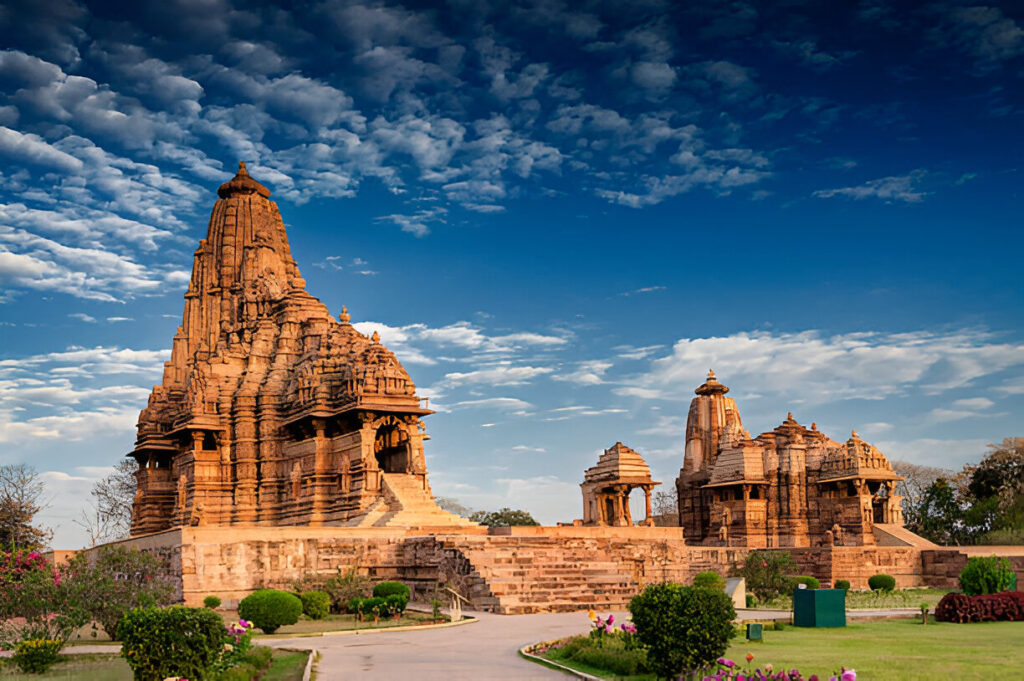
Read Also
- Umngot River: Meghalaya’s Crystal-Clear Gem
- Top Tourist Places in Kashmir
- Stargazing in India: Top Places to See the Milky Way
- Top 10 Eco-Tourism Destinations in the World
- Best places to visit in Himachal Pradesh
- Mawlynnong: Asia’s Cleanest Village
- Sikkim Wins Best State Award for Environment Education
- Top Eco-Tourism Destinations for Nature Lovers
- Exploring India’s Best Tourism Villages
- 10 Most Breathtaking Natural Wonders in the World
- India’s UNESCO World Heritage Sites
- Tibetan Prayer Flags
- Important Festivals Celebrated in India
- The Evolution of Money: From Barter to Digital Currency

Portable Storage Organizer for USB Cable, Earphone, Power Bank, Charger, Hard Disk & Digital Gadgets, with Mesh Pockets Size 21x12cm Inside’s Material and Color May Vary
Perfect for various occasions, the small size & lightweight design of this cable organizer pouch make it an excellent choice for holidays, business trips, travel, & office use. Its versatility extends to being a great gift for yourself or to share with family & friends.
Frequently Asked Questions (FAQs)
India is home to several iconic historical places, including the Taj Mahal (Agra), Red Fort (Delhi), Qutub Minar (Delhi), Hampi (Karnataka), Amer Fort (Rajasthan), and Ajanta & Ellora Caves (Maharashtra).
The Indus Valley Civilization sites, such as Mohenjo-Daro, Harappa (Pakistan), and Lothal (Gujarat, India), are among the oldest known historical sites, dating back to 2500 BCE.
India has several UNESCO World Heritage Sites, including the Taj Mahal, Jaipur City, Fatehpur Sikri, Hampi, Khajuraho Temples, and Elephanta Caves.
The Taj Mahal in Agra is one of the most visited historical monuments in India, attracting millions of tourists from around the world every year.
The ideal time to visit historical places in India is from October to March when the weather is pleasant for sightseeing and exploration.






Can you be more specific about the content of your article? After reading it, I still have some doubts. Hope you can help me. https://accounts.binance.com/zh-TC/register-person?ref=VDVEQ78S